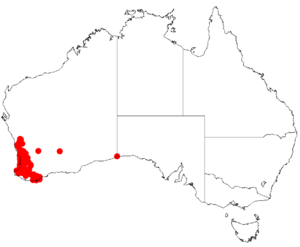Two-winged acacia facts for kids
Quick facts for kids Two-winged acacia |
|
|---|---|
| Scientific classification | |
| Genus: |
Acacia
|
| Species: |
willdenowiana
|
 |
|
| Occurrence data from AVH | |
Acacia willdenowiana is a type of shrub in the Acacia family. People often call it wattle grass, grass wattle, or two-winged acacia. This plant naturally grows in the southwest part of Western Australia.
Contents
What Does Two-Winged Acacia Look Like?
This shrub usually grows upright and thin, but sometimes it can spread out. It typically reaches a height of about 0.3 to 0.6 meters (1 to 2 feet) and can spread about 0.5 meters (1.6 feet) wide. As it gets older, it develops a strong, woody stem at its base.
Unique Leaves of the Two-Winged Acacia
The plant has special leaf-like parts called phyllodes. These phyllodes are connected directly to the branches and look like opposing wings. Each grey-green wing is usually 1 to 5 millimeters (0.04 to 0.2 inches) wide, but some can be as wide as 15 millimeters (0.6 inches). They are usually smooth and hairless. The free part of each phyllode is typically 5 to 20 millimeters (0.2 to 0.8 inches) long.
Flowers and Seed Pods
The two-winged acacia blooms between May and October. It produces beautiful white, cream, or pale yellow flowers. These flowers grow in round clusters, with each cluster having 13 to 21 small flowers. After the flowers, seed pods begin to form. These pods are curved and flat, growing up to about 6 centimeters (2.4 inches) long and 10 to 15 millimeters (0.4 to 0.6 inches) wide. Inside the pods are oblong seeds, each about 5 to 6 millimeters (0.2 to 0.24 inches) long.
How Scientists Named and Classified This Plant
The Acacia willdenowiana was first officially described by a botanist named Heinrich Wendland in 1845. He wrote about it in his work called Verzeichniss von Treib-Glashaus-Bosquet-Pflanzen, Standen-Gewachsen und Georginen ... zu Herrenhausen bei Hannover.
Changes in Its Scientific Name
For a short time in 2003, another botanist, Leslie Pedley, reclassified it as Racosperma willdenowianum. However, by 2006, its original name, Acacia willdenowiana, was brought back. The species name willdenowiana honors Carl Ludwig Willdenow, a famous German botanist.
Early Discoveries
The first official sample of this plant was collected by James Drummond in the Swan River Colony in 1839.
Similar Acacia Plants
Until 1995, another plant called Acacia applanata was thought to be the same species as A. willdenowiana. A. willdenowiana also looks similar to Acacia alata, and its phyllodes resemble those of Acacia pterocaulon.
Where Does Two-Winged Acacia Grow?
This plant is found in different areas across Western Australia. You can see it in the Mid West, Wheatbelt, Peel, and Great Southern regions. It grows as far north as Three Springs, south to Albany, and east to Mukinbudin.
Preferred Growing Conditions
The two-winged acacia can grow in different types of soil, including loam, sandy soil, or lateritic soil. It often thrives in areas that get wet during winter. You can usually find it growing as part of the undergrowth in woodlands or open woodland areas.
Growing Two-Winged Acacia in Your Garden
This plant is not widely available for sale, but it can be a great addition to a garden. It grows best in a sunny spot with soil that drains well.
Care and Uses
It's a good choice for a native garden or as a special plant in garden borders. The two-winged acacia can handle both frost and dry periods, so it's quite tough. It also doesn't need much pruning, which makes it easy to care for.
Images for kids


